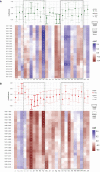Radiocarbon and wood anatomy as complementary tools for generating tree-ring records in Bolivia
- PMID: 36909413
- PMCID: PMC9997647
- DOI: 10.3389/fpls.2023.1135480
Radiocarbon and wood anatomy as complementary tools for generating tree-ring records in Bolivia
Abstract
The science of tropical dendrochronology is now emerging in regions where tree-ring dating had previously not been considered possible. Here, we combine wood anatomical microsectioning techniques and radiocarbon analysis to produce the first tree-ring chronology with verified annual periodicity for a new dendrochronological species, Neltuma alba (commonly known as "algarrobo blanco") in the tropical Andes of Bolivia. First, we generated a preliminary chronology composed of six trees using traditional dendrochronological methods (i.e., cross-dating). We then measured the 14C content on nine selected tree rings from two samples and compared them with the Southern Hemisphere (SH) atmospheric 14C curves, covering the period of the bomb 14C peak. We find consistent offsets of 5 and 12 years, respectively, in the calendar dates initially assigned, indicating that several tree rings were missing in the sequence. In order to identify the tree-ring boundaries of the unidentified rings we investigated further by analyzing stem wood microsections to examine anatomical characteristics. These anatomical microsections revealed the presence of very narrow terminal parenchyma defining several tree-ring boundaries within the sapwood, which was not visible in sanded samples under a stereomicroscope. Such newly identified tree rings were consistent with the offsets shown by the radiocarbon analysis and allowed us to correct the calendar dates of the initial chronology. Additional radiocarbon measurements over a new batch of rings of the corrected dated samples resulted in a perfect match between the dendrochronological calendar years and the 14C dating, which is based on good agreement between the tree-ring 14C content and the SH 14C curves. Correlations with prior season precipitation and temperature reveal a strong legacy effect of climate conditions prior to the current Neltuma alba growing season. Overall, our study highlights much potential to complement traditional dendrochronology in tree species with challenging tree-ring boundaries with wood anatomical methods and 14C analyses. Taken together, these approaches confirm that Neltuma alba can be accurately dated and thereby used in climatic and ecological studies in tropical and subtropical South America.
Keywords: Bolivia; Neltuma alba; South America; algarrobo blanco; bomb-pulse radiocarbon dating; tropical dendrochronology.
Copyright © 2023 Pacheco-Solana, Oelkers, D’Arrigo, Santos, Rodriguez-Caton, Tejedor, Ferrero, Fuentes, Maldonado and Andreu-Hayles.
Conflict of interest statement
The authors declare that the research was conducted in the absence of any commercial or financial relationships that could be construed as a potential conflict of interest.
Figures








References
-
- Ambite S., Ferrero Eugenia M., Piraino S., Badagian J., Muñoz A. A., Aguilera-Betti I., et al. . (2022). Prosopis l. woody growth in relation to hydrology in south America: A review. Dendrochronologia 76, 126017. doi: 10.1016/j.dendro.2022.126017 - DOI
-
- Ancapichún S., Pol-Holz De R., Christie D. A., G., Santos M., Collado-Fabbri S., Garreaud R., et al. et al. . (2021). Radiocarbon bomb-peak signal in tree-rings from the tropical andes register low latitude atmospheric dynamics in the southern hemisphere. Sci. Total Environ. 774, 145126. doi: 10.1016/j.scitotenv.2021.145126 - DOI - PubMed
-
- Andreu-Hayles L., Santos G. M., Herrera-Ramírez D. A., Martin-Fernández J., Ruiz-Carrascal D., Boza-Espinoza T. E, et al. . (2015). Matching dendrochronological dates with the southern hemisphere 14 c bomb curve to confirm annual tree rings in pseudolmedia rigida from Bolivia. Radiocarbon 57 (1), 1–13. doi: 10.2458/azu_rc.57.18192 - DOI
-
- Andreu-Hayles L., Levesque M., Martin-Benito D., Huang W., Harris R., Oelkers R., et al. . (2019). A high yield cellulose extraction system for small whole wood samples and dual measurement of carbon and oxygen stable isotopes. Chem. Geol. 504, 53–65. doi: 10.1016/j.chemgeo.2018.09.007 - DOI
LinkOut - more resources
Full Text Sources
Miscellaneous

